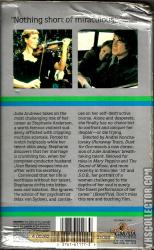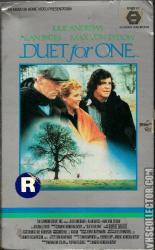Duet For One
Catalog Number
MV801117
-
Primary Distributor (If not listed, select "OTHER")
Catalog Number
MV801117
Primary Distributor (If not listed, select "OTHER")
Release Year
Country
N/A (NTSC)
N/A | N/A | N/A
N/A | N/A
Duet For One (1986)
Additional Information
Additional Information
Julie Andrews delivers a virtuoso dramatic performance in Duet for One. Based on a play by Tom Kempinski, the story concerns brilliant concert violinist Stephanie Anderson (Andrews) who is slowly succumbing to the ravages of multiple sclerosis. Stephanie's problems are compounded by her cheating husband David Cornwallis (Alan Bates), and her protégé Constantine Kassanis (Rupert Everett), who shows signs of "selling out" to popular entertainment. Max von Sydow, who previously co-starred with Andrews in Hawaii, plays psychiatrist Dr. Louis Feldman, who tries to help Stephanie cope with her debilitations, but who ends up as much an albatross around her neck as David and Constantine. Critics are still divided over whether or not the mystical sequences between Andrews and the ghost of her violin teacher (Sigfrit Steiner) truly work within the context of the plotline. Duet for One was the third English-language production for Russian filmmaker Andrei Konchalovsky.
Duet for One (1986) is a film adapted from a British play, a two-hander by Tom Kempinski, about a world-famous concert violinist named Stephanie Anderson who is suddenly struck with multiple sclerosis.[2] It is set in London and directed by Andrei Konchalovsky. The story is based on the life of cellist Jacqueline du Pré, who was diagnosed with MS, and her husband, conductor Daniel Barenboim, and only marginally fictionalized.
Stephanie Anderson is suffering from multiple sclerosis and she is slipping into the depths of depression. She begins seeing a psychiatrist and despises him for not being able to feel her pain. Her conductor husband is also drifting away from her, having an affair with his secretary. Stephanie shuts herself away from the world, once locking her door and replaying her old concert tapes, watching despairingly as her on-screen self plays music that she will never be able to create again. She attempts suicide but fails when her maid rescues her. Soon, however, she comes to terms with the facts of her bitter end and realizes that life must go on.
Release Date: December 25, 1986 (February 11, 1987 Nationwide)
Duet for One (1986) is a film adapted from a British play, a two-hander by Tom Kempinski, about a world-famous concert violinist named Stephanie Anderson who is suddenly struck with multiple sclerosis.[2] It is set in London and directed by Andrei Konchalovsky. The story is based on the life of cellist Jacqueline du Pré, who was diagnosed with MS, and her husband, conductor Daniel Barenboim, and only marginally fictionalized.
Stephanie Anderson is suffering from multiple sclerosis and she is slipping into the depths of depression. She begins seeing a psychiatrist and despises him for not being able to feel her pain. Her conductor husband is also drifting away from her, having an affair with his secretary. Stephanie shuts herself away from the world, once locking her door and replaying her old concert tapes, watching despairingly as her on-screen self plays music that she will never be able to create again. She attempts suicide but fails when her maid rescues her. Soon, however, she comes to terms with the facts of her bitter end and realizes that life must go on.
Release Date: December 25, 1986 (February 11, 1987 Nationwide)






Comments0
Login / Register to post comments